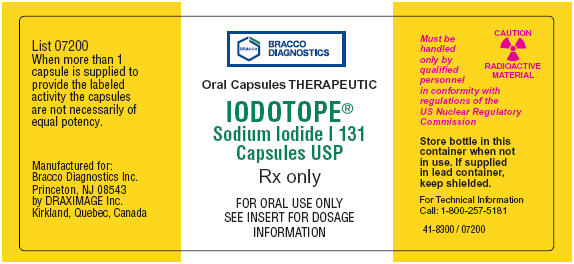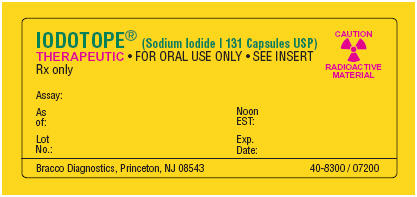IODOTOPE
-
sodium iodide i-131 capsule, gelatin coated
Bracco Diagnostics Inc
----------
DESCRIPTION
Iodotope preparations for therapeutic use are radiopharmaceuticals containing sodium iodide I 131 in capsules for oral administration. Capsules are available in units of 37 to 4810 megabecquerels (1 to 130 millicuries) at the time of calibration.
Sodium iodide I 131 is designated chemically as Na131I (MW 153.99).
PHYSICAL CHARACTERISTICS
Iodine 131 decays by beta emission and associated gamma emission with a physical half-life of 8.04 days.1 Photons that are useful for detection and imaging are listed in Table 1.
| Principal Radiation Emission Data | ||
|---|---|---|
| 1Kocher, David C., "Radioactive Decay Data Tables", DOE/TIC-11026, (1981) p. 133. | ||
| Radiation | Mean % per Disintegration | Mean Energy (keV) |
| Beta-4 (average) | 89.3 | 191.6 |
| Gamma-14 | 81.2 | 364.5 |
External Radiation
The specific gamma ray constant for iodine 131 is 2.2 R/hour-millicurie at 1 cm. The first half-value thickness of lead (Pb) for iodine 131 is 0.24 cm. A range of values for the relative attenuation of the radiation emitted by this radionuclide that results from interposition of various thicknesses of Pb is shown in Table 2. For example, the use of 2.55 cm of Pb will decrease the external radiation exposure by a factor of about 1,000.
| Radiation Attenuation by Lead Shielding | |
|---|---|
| Shield Thickness (Pb) cm | Coefficient of Attenuation |
| 0.24 | 0.5 |
| 0.89 | 10-1 |
| 1.6 | 10-2 |
| 2.55 | 10-3 |
| 3.73 | 10-4 |
To correct for physical decay of iodine 131, the fractions that remain at selected intervals after the time of calibration are shown in Table 3.
| Physical Decay Chart: Iodine 131 half-life 8.04 days | |||||
|---|---|---|---|---|---|
| Days | Fraction Remaining | Days | Fraction Remaining | Days | Fraction Remaining |
| *Calibration time | |||||
| 0* | 1.000 | 11 | .388 | 21 | .164 |
| 1 | .918 | 12 | .356 | 22 | .151 |
| 2 | .842 | 13 | .327 | 23 | .138 |
| 3 | .773 | 14 | .300 | 24 | .127 |
| 4 | .709 | 15 | .275 | 25 | .116 |
| 5 | .651 | 16 | .253 | 26 | .107 |
| 6 | .597 | 17 | .232 | 27 | .098 |
| 7 | .548 | 18 | .213 | 28 | .090 |
| 8 | .503 | 19 | .195 | 29 | .083 |
| 9 | .461 | 20 | .179 | 30 | .076 |
| 10 | .423 | ||||
CLINICAL PHARMACOLOGY
Sodium iodide I 131 is readily absorbed from the gastrointestinal tract. Following absorption, the iodide is primarily distributed within the extracellular fluid of the body. It is trapped and rapidly converted to protein bound iodine by the thyroid; it is concentrated, but not protein bound, by the stomach and salivary glands. It is also promptly excreted by the kidneys. About 90 percent of the local irradiation is caused by beta radiation and 10 percent is caused by gamma radiation.
INDICATIONS AND USAGE
Therapeutic doses of Iodotope (Sodium Iodide I 131 Capsules USP) are indicated for the treatment of hyperthyroidism and selected cases of carcinoma of the thyroid. Palliative effects may be seen in patients with papillary and/or follicular carcinoma of the thyroid. Stimulation of radioiodide uptake may be achieved by the administration of thyrotropin. (Radioiodide will not be taken up by giant cell and spindle cell carcinoma of the thyroid or by amyloid solid carcinomas.)
CONTRAINDICATIONS
Preexisting vomiting and diarrhea represent contraindications to the therapeutic use of radioiodide.
Iodotope therapeutic capsules (Sodium Iodide I 131 USP) may cause fetal harm when administered to a pregnant woman. Permanent damage to the fetal thyroid can occur.
Iodotope therapeutic capsules (Sodium Iodide I 131 USP) are contraindicated in women who are or may become pregnant. If this drug is used during pregnancy, or if the patient becomes pregnant while taking this drug, the patient should be appraised of the potential hazard to the fetus.
Animal reproduction studies have not been conducted with sodium iodide I 131.
WARNINGS
Sodium iodide I 131 is not usually used for the treatment of hyperthyroidism in patients under 30 years of age unless circumstances preclude other methods of treatment.
PRECAUTIONS
General
The uptake of radioiodide will be affected by recent intake of stable iodine in any form, or by the use of thyroid, anti-thyroid and certain other drugs. Accordingly, the patient should be questioned carefully regarding previous medication and procedures involving radiographic contrast media.
This drug should not be used after the expiration date stated on the container label. Radiopharmaceuticals should be used only by physicians who are qualified by training and experience in the safe use and handling of radionuclides, and whose experience and training have been approved by the appropriate government agency authorized to license the use of radionuclides.
As in the use of any radioactive material, care should be taken to minimize radiation exposure to the patient consistent with proper patient management and to insure minimum radiation exposure to occupational workers.
Carcinogenesis, Mutagenesis, Impairment of Fertility
No long term animal studies have been performed to evaluate carcinogenic potential.
ADVERSE REACTIONS
The immediate adverse reactions following sodium iodide I 131 treatment of hyperthyroidism are usually mild. Following the larger doses used in treating thyroid carcinoma, adverse reactions may be much more severe and present special problems. Untoward effects which may be associated with the use of sodium iodide I 131 include depression of the hematopoietic system when large doses are employed, radiation sickness (some degree of nausea and vomiting), increase in clinical symptoms, bone marrow depression, severe sialoadenitis, acute leukemia, anemia, chromosomal abnormalities, acute thyroid crises, blood dyscrasia, leukopenia, or thrombocytopenia.
Tenderness and swelling of the neck, pain on swallowing, sore throat, and cough may occur around the third day after treatment and are usually amenable to analgesics.
Temporary thinning of the hair may occur two to three months after treatment. Allergic type reactions have been reported infrequently following the administration of iodine-containing radiopharmaceuticals.
OVERDOSAGE
In the treatment of hyperthyroidism, overdosage may result in hypothyroidism, the onset of which may be delayed. Appropriate replacement therapy is recommended if hypothyroidism occurs. Radiation absorbed doses to various tissues for any administered dose may be calculated by reference to Table 4 (Absorbed Radiation Doses).
DOSAGE AND ADMINISTRATION
Hyperthyroidism: The total amount of sodium iodide I 131 needed to achieve a clinical remission without destruction of the entire thyroid gland has been found to vary widely; the usual dose range is 148 to 370 megabecquerels (4 to 10 millicuries). Toxic nodular goiter and other special situations will require the use of larger doses.
Carcinoma of the thyroid: Dosage must be determined individually. The usual dose for ablation of normal thyroid tissue is 1850 megabecquerels (50 millicuries), with subsequent therapeutic doses usually 3700 to 5550 megabecquerels (100 to 150 millicuries).
The patient dose should be measured by a suitable radioactivity calibration system immediately prior to administration.
Radiation Dosimetry
Following oral administration of sodium iodide I 131, about 40 percent of the activity has an effective half-life of 0.34 days and 60 percent has an effective half-life of 7.61 days. On this basis the estimated absorbed radiation doses to an average adult (70 kg) from an oral dose of 370 MBq (10 mCi) of sodium iodide I 131 are shown in Table 4.
| Absorbed Radiation Doses I-131 |
||
|---|---|---|
| Tissue | mGy/370 MBq | rads/10 mCi |
| Thyroid | 350,000 | 35,000.0 |
| Testes | 92 | 9.2 |
| Ovaries | 93 | 9.3 |
| Whole-body | 160 | 16.0 |
Method of Calculation: A Schema for Absorbed-Dose Calculations for Biologically Distributed Radionuclides, MIRD Pamphlet No. 1. J Nucl Med Suppl 1:7, 1968
HOW SUPPLIED
Iodotope (Sodium Iodide I 131 Capsules USP) blue/buff therapeutic capsules containing 37 to 4810 megabecquerels (1 to 130 millicuries) sodium iodide I 131 at the time of calibration are available in packages of 37 to 5550 megabecquerels (1 to 150 millicuries) at the time of calibration.
Storage
Sodium Iodide I 131 Capsules should be stored as supplied at 25 °C (77 °F), excursions permitted to 15-30 °C (59-86 °F) [See USP Controlled Room Temperature].
The U.S. Nuclear Regulatory Commission has approved this prepared
radiopharmaceutical for distribution to persons licensed to use byproduct
material identified in §35.300 of 10 CFR Part 35, to persons who
hold an equivalent license issued by an Agreement State, and, outside
the United States, to persons authorized by the appropriate authority.
Manufactured for
Bracco Diagnostics Inc.
Princeton, NJ 08543
by DRAXIMAGE, a division of
DRAXIS Specialty Pharmaceuticals Inc.
Kirkland Quebec H9H 4J4 Canada
Printed in Canada
Revised December 2006
43-8300A
| IODOTOPE
sodium iodide, i-131 capsule, gelatin coated |
||||||||||||||||||
|
||||||||||||||||||
|
||||||||||||||||||
|
||||||||||||||||||
|
||||||||||||||||||
| Marketing Information | |||
| Marketing Category | Application Number or Monograph Citation | Marketing Start Date | Marketing End Date |
| NDA | NDA010929 | 06/14/1957 | 06/19/2008 |
| Labeler - Bracco Diagnostics Inc (849234661) |
| Registrant - Bracco Diagnostics Inc (849234661) |
| Establishment | |||
| Name | Address | ID/FEI | Operations |
| Jubilant Draximage Inc | 243604761 | MANUFACTURE | |
Revised: 01/2013 Bracco Diagnostics Inc

